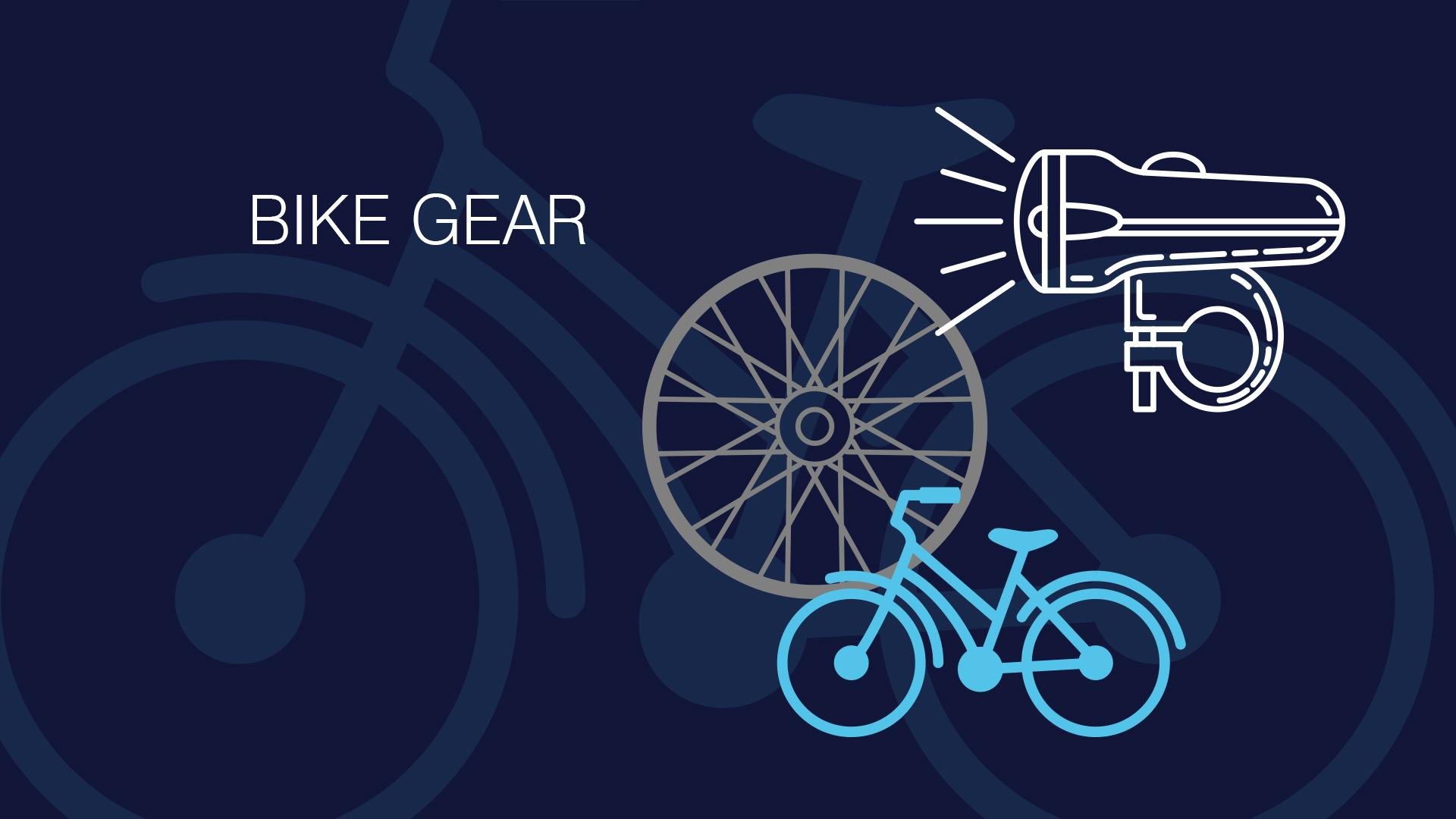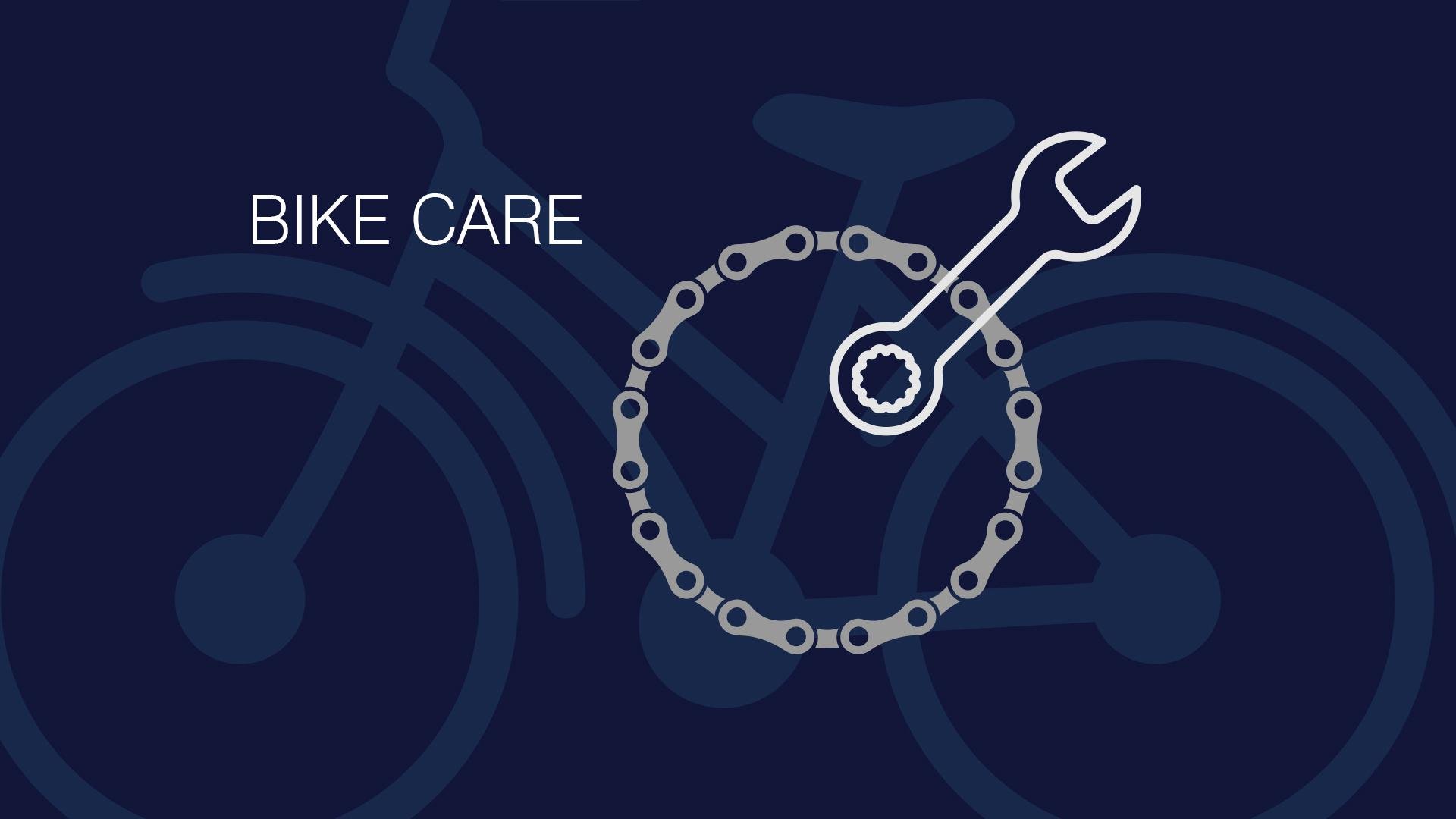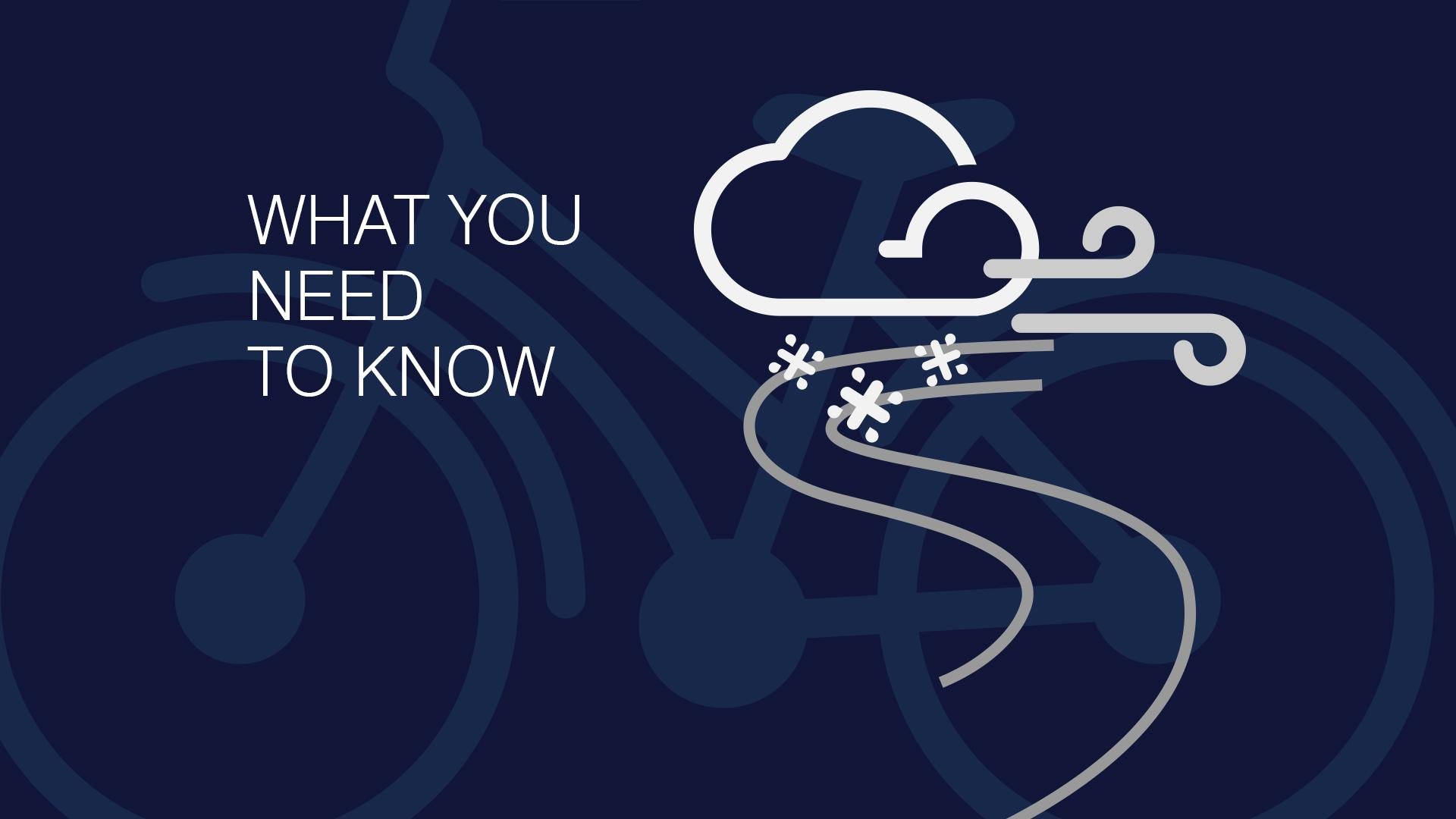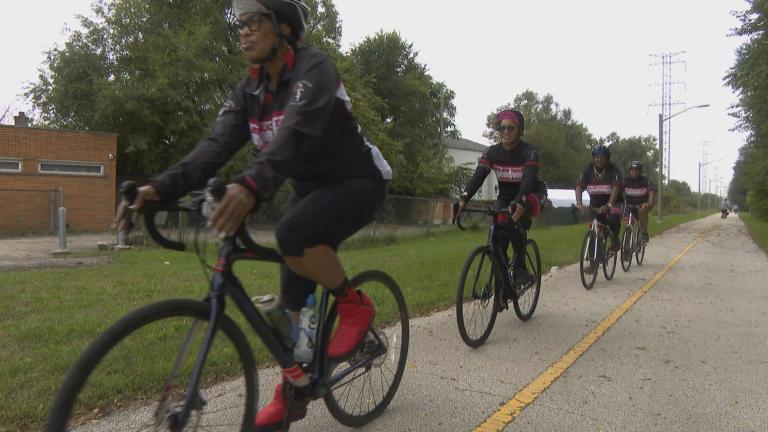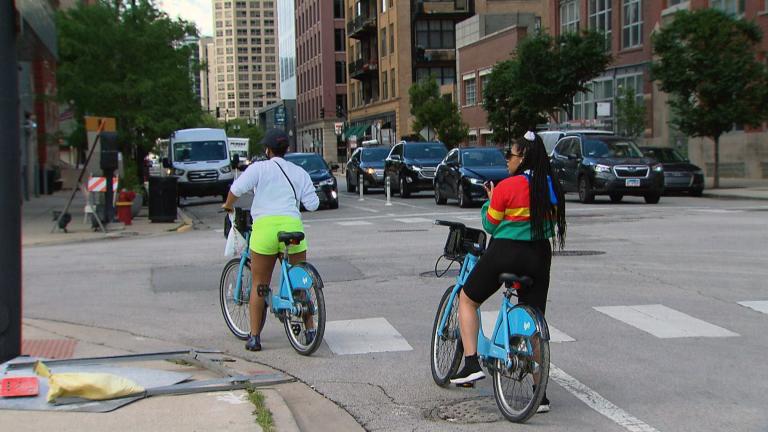The COVID-19 pandemic has driven a huge increase in bicycling, with more people turning to two wheels for exercise, recreation and a way to get around without taking transit.
While the late fall weather this year has been relatively mild, riding a bicycle through a Chicago winter likely sounds daunting to many first-timers. But with a bit of preparation and the right attitude, it’s a manageable feat.
If you’re looking to bike your way through the winter, here’s some advice from avid cyclists on how to proceed as safely and enjoyably as possible.
Inside this guide:
Bike Gear | Bike Care | What You Need | What You Need to Know
Light up: No matter what time of the year you’re riding, having good lights for your bike is critical — but especially in winter, when days are shorter and snow and ice can obstruct your path.
“Particularly if you’re biking at night in those conditions, you need a really good light to illuminate the path ahead of you,” said Lynda Lopez of the Active Transportation Alliance. “I definitely prioritize getting good lights. I bought new lights a few months ago because I was already thinking my current light is getting a little dimmer and (it was) getting darker earlier.”
Fenders are your friend: Lopez also recommends getting fenders for riding in wetter weather. “That keeps your wheel from kicking up debris when it’s snowing or raining,” she said. “I think I learned that after my clothes kept getting really dirty — ‘Oh my god, I have so much dirt on my jacket!’ So I went out and bought fenders.”
Tire upgrades: Some cyclists also like to make some seasonal changes to their bikes. “Depending on what type of bike you have, like road bikes or cruisers, maybe look for some type of upgraded tires,” said Joshua Fort, production mechanic at Blackstone Bicycle Works.
Gear guide: If you want more recommendations, the bike lane obstruction database Bike Lane Uprising has put together winter gear recommendations as well as a 2020 holiday gift guide. Like the database, the suggestions in the guides are crowdsourced from cyclists themselves.
Christina Whitehouse, founder of Bike Lane Uprising, says not to be daunted if you’re unsure how much gear to get — or how much it’s going to cost.
“You shouldn’t need to purchase hundreds and hundreds of dollars’ worth of gear,” Whitehouse said. “We’re conscious of the fact there’s a lot of people that bike that who can’t afford super high-end things … so we try to be very conscious of if you’re on a budget.”
And, Whitehouse says, all the recommendations are items the cyclists who submitted them use and value. “They’re coming from people that have had pretty tight budgets and when it’s an item that those people say you should splurge on, it’s usually a pretty good notion that you should splurge on those particular things.”
Consider an alternative: If the whole idea of outfitting your bike for the cold-weather months seems too daunting, Courtney Cobbs of Streetsblog Chicago says you can also consider using Chicago’s bike sharing system.
“I have my own bike and I have a Divvy membership. Last winter I found it really helpful to ride a Divvy bike on the days where there was snow on the ground, just because the bikes are heavier and they do better in the snow,” Cobbs said. “They’re not completely foolproof … but it was a lot more stable than your regular road bike.”
If you’re interested but don’t have a Divvy membership, you may want to sign up soon. Annual membership costs $99 but is going up to $108 on Jan. 1. You may also qualify for a discounted membership through the Divvy for Everyone program.
Cover up: Just like a car, winter weather can be tough on your bike. Blackstone’s Joshua Fort says if you can, the best way to keep your bike in good condition is to store it indoors. If you don’t have that option, covering it with a tarp after you lock it up will also help.
Wipe down: “Even if you can’t do that, just a daily wipe-down will go so far. Snow and rain just eats at your components,” Fort said, not to mention the salt used to keep roads dry. “Stuff like that is not good for aluminum, metal, anything like that … I’ve seen so many bikes get rusted from things like that.”
Bike oil only, please: Fort also says that while it’s important to keep your bike’s chain and other moving components oiled, it’s important to use something specific to bikes — not WD-40, a “common myth” he wants to help debunk.
“WD-40 does not actually always help your bike. It’s just a quick fix, but if you read the can of WD-40, it says that it actually dries things. It’s going to help it momentarily if you spray a chain or something, but all in all you’re not helping it,” Fort said.
Layer up ... carefully: Among the many things Chicagoans pride themselves on is knowing how to layer up in the cold weather. Layers are important for winter cycling, too, but it’s important to remember that if you ride for any significant length of time you’re likely to heat up.
“It’s a double-edged sword,” said Fort. “The best I can say is, always bring enough. It’s easier to undress than dress up.”
Cobbs says it’s important to pay attention to “where your cold spots are and where your hot spots are. I tend to be really warm up top, but my legs are cold. For some people it’s the opposite. I have two jackets that I wear depending on the weather, because I find that wearing a big heavy coat, I can arrive to my destination really sweaty.”
Protect your extremities: “Try to focus on what body parts are getting the coldest first and think about ways to make those areas more comfortable,” Whitehouse said. For many people, that’s their feet. Whitehouse says merino wool socks are popular for cyclists — but if you don’t want to spring for those right away, Uniqlo’s HEATTECH socks are a good discount option.
Experienced riders also recommend gloves or mittens thick enough to keep your hands warm but that offer enough flexibility to maneuver, brake and shift gears. Some cyclists will also layer their gloves, wearing a thinner athletic-style pair of gloves under a warmer pair.
Mighty who? Another recommendation: bar mitts, which are “little mitts that go on your bike handles,” Cobbs said. “They help keep your hands a little bit warmer than they would be otherwise.”
And again, if you don’t want to spend the money on bar mitts right away, Whitehouse says you can get crafty.
“Some people use cardboard boxes instead,” she said. “We’ve seen plastic envelopes, all sorts of things just to block the wind off of your hands.”
Mask up: Anyone who’s lived through a Chicago winter knows how uncomfortable sharp winds feel on an exposed face.
“I have a few balaclavas — they’re basically face masks, so they protect your head and your face. I would definitely recommend that,” said Lopez. “The wind, I would say, is one of the biggest deterrents to wanting to bike outside during the cold. If you don’t have a face mask it’s not going to be very fun.”
Take it slow: Just as drivers aren’t born knowing how to navigate wintry conditions, neither are cyclists. Those we spoke with all stressed the importance of taking things slowly, practicing and being comfortable with learning as you go.
“It seems like a nice-weather activity, but I think there’s ways to go about it where you can still have fun on your bike in the winter. And I think fun is a big factor for me. I’m not really going to get on my bike if it’s not fun at all!” Lopez said with a laugh. “It’s a process. I’m always learning new things every year that I’m biking in the winter.”
“Quite a bit of it is starting to get over that mental hump and being open to trying it out,” Whitehouse said. “Maybe don’t wait till the day you have an important meeting or somewhere critical (to be). Maybe try it out on a day that you’re just looking for something to do and try to find a nice little route.”
Brake with caution: For people who know how to drive a car, some of those driver’s ed lessons also apply to bikes.
“If you’re going through snow or riding on top of ice, never hit your brakes,” said Fort. “Always just ride through it. If you feel your wheel slide, never hit brakes. Hitting brakes on top of ice is going to make it way worse. If you can, just balance yourself out and let the wheel spin through.”
Know thyself: Practice will also help you learn your limits as a cyclist, advises Cobbs. “I don’t take as long a trip as I typically would in warmer weather. For example, I may not do a 12-mile ride, but a 5-mile ride is totally fine,” she said.
She also suggests being cautious when sharing the road with cars on snowy or icy days.
“They may not realize that you’re trying to stick to the part of the road where there is no ice or there is no snow and you’re just going a little bit slower. I typically put my hand behind me to signal like, OK, back off a little bit, I’m going to be out of your way soon enough. And if you can, maybe pull over and let that person go in front of you so you’re able to continue to move at a pace that feels comfortable to you,” she said.
Safety in numbers: Whitehouse said she’s looking forward to seeing more cyclists on the road this winter.
“The more people that bike all year round, the safer it actually is for everyone because drivers will be very familiar (with seeing) the cyclists,” she said.
One key piece of advice we heard time and time again from the cyclists we spoke with? Take things at your own pace and don’t feel like you have to impress anyone with your cycling skills.
“No one’s thinking negatively about you trying to figure things out,” Whitehouse said.
Follow Nick Blumberg on Twitter: @ndblumberg

